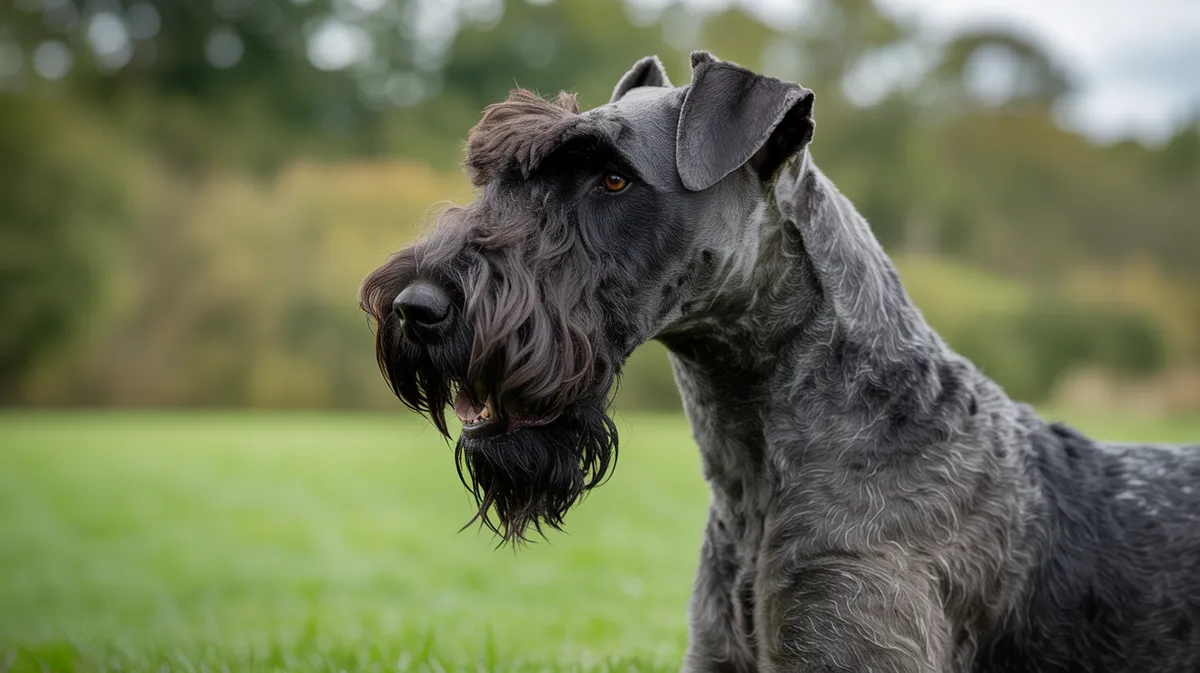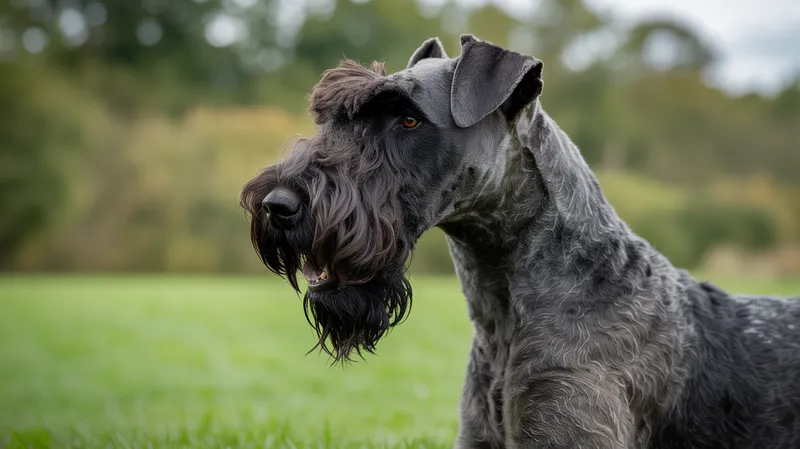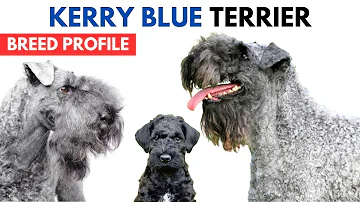
Kerry Blue Terrier
Canis lupus familiaris

Meet the Kerry Blue Terrier
The Kerry Blue Terrier is a medium-sized dog breed originating from County Kerry, Ireland, renowned for its distinctive soft, wavy blue-gray coat. Developed as a versatile working dog, it was historically used for hunting vermin, herding livestock, and serving as a loyal companion. The breed is intelligent, energetic, and spirited, with a reputation for being both affectionate and protective of its family. Its hypoallergenic coat and unique appearance make it a popular choice for those seeking a distinctive and active pet. Kerry Blue Terriers require regular grooming and early socialization due to their strong-willed nature.
Classification
Mammal
Habitat
Domestic environments; originally rural farmlands
Diet
Omnivore
Lifespan
12-15 years
Conservation
Least Concern
Weight
15-18 kg (33-40 lbs)
📖Fascinating Facts
Color-Changing Coat
Kerry Blue Terrier puppies are born black, and their coats gradually turn blue-gray as they age, usually reaching their final color by 18 months.
Irish Heritage
This breed is deeply connected to Irish culture and was once so highly regarded that it was featured at the first Irish Kennel Club show in 1922.
High Grooming Needs
Their dense, curly coat does not shed, but requires regular brushing and professional grooming to prevent matting and maintain its signature look.
📋Detailed Description
The Kerry Blue Terrier is a robust, medium-sized breed, typically weighing 12–15 kg for males and 10–13 kg for females, with males standing 46–48 cm and females 44–46 cm at the withers. Its most distinctive feature is its dense, soft, and wavy 'blue' coat, which actually ranges from deep slate to silvery gray, developing from an initial black puppy coat through progressive greying—a process known as 'clearing.' The breed possesses a well-proportioned, muscular body, a deep chest, and a strong, slightly arched neck, supporting a long, flat head with a pronounced stop and expressive, dark eyes. The Kerry Blue Terrier is renowned for its keen intelligence, agility, and versatility, originally bred for a wide array of tasks including vermin control, herding, and water retrieval. Its temperament is spirited, alert, and affectionate, often forming close bonds with family members while displaying a natural wariness toward strangers and assertiveness with other dogs. The breed is highly energetic and requires substantial mental and physical stimulation, thriving in active households. Its hypoallergenic coat, which sheds minimally, demands regular grooming and professional trimming to prevent matting. Anatomically, the breed’s powerful jaws, strong teeth, and agile frame reflect its historical role as a hunter and working dog. Socially, Kerry Blues are known for their loyalty and protective instincts, making them excellent watchdogs, though early socialization is critical to temper their assertive nature. Their adaptability and trainability have also made them successful in modern canine sports such as agility, obedience, and tracking.
💡 Did you know?
Despite their elegant look and blue coat, Kerry Blue Terriers were originally bred to control pests and herd livestock on Irish farms.
🔬Research & Sources
Wikipedia Summary
The Kerry Blue Terrier is a breed of dog. Originally bred to control vermin including rats, rabbits, badgers, ferrets, foxes, otters, hares, deer, and even wolves, over time the Kerry became a general working dog used for a variety of jobs including herding cattle and sheep. Despite a Kerry Blue winning Crufts in 2000, it remains an "unfashionable" breed, and is distinctly uncommon; however, it is not as threatened as some of the other terrier breeds such as the Skye Terrier, Sealyham Terrier, and Dandie Dinmont Terrier.
Last Modified: 1/24/2025
🎭Behavior & Social Structure
Kerry Blue Terriers are highly intelligent, energetic, and inquisitive, displaying a strong prey drive and a natural inclination for problem-solving. Historically, they excelled at independent hunting, often working alone or in pairs to track and dispatch vermin such as rats, rabbits, and even larger quarry like foxes and badgers. Their feeding behavior is typical of domestic dogs, but their hunting instincts may manifest as chasing small animals or displaying tenacity during play. Socially, they are affectionate with family members and can be playful and gentle with children, but may exhibit dominance or territoriality toward unfamiliar dogs. Daily routines should include ample exercise, interactive play, and mental challenges to prevent boredom-related behaviors such as digging or excessive barking. Kerry Blues are known for their 'terrier fire,' a spirited and sometimes stubborn disposition, but they respond well to consistent, positive reinforcement training. They may be reserved or aloof with strangers, making them effective watchdogs, but early socialization is essential to prevent aggression or excessive wariness.
👶Reproduction & Life Cycle
Kerry Blue Terriers typically reach sexual maturity between 8 and 12 months of age, though responsible breeding is advised after 18 months. The breed is monoestrous, with females coming into heat approximately twice a year. Mating is usually preceded by courtship behaviors such as sniffing, licking, and play. The gestation period averages 63 days, after which litters of 4–8 puppies are common. Puppies are born with a solid black coat, which gradually transitions to the characteristic blue-gray shade over the first 18–24 months. Parental care is primarily provided by the dam, who nurses and grooms the puppies intensively during the first three weeks. Breeders often begin early socialization and gentle handling at 2–3 weeks of age to foster stable temperaments. Weaning typically occurs at 6–8 weeks, and puppies are usually ready for placement in new homes by 8–10 weeks. The breed does not have a defined breeding season, as is typical for domestic dogs.
🛡️Adaptations & Survival
The Kerry Blue Terrier's dense, curly, and water-resistant coat is a unique adaptation that enabled the breed to work in Ireland’s wet and rugged terrain, providing insulation and protection from the elements. Their strong, muscular build and agile frame allowed them to pursue prey over rough ground and through water. The breed’s pronounced jaw strength and scissor bite were advantageous for dispatching vermin and defending livestock. Behaviorally, their intelligence and independence facilitated problem-solving and adaptability to a variety of working roles, from hunting to herding. Their hypoallergenic coat is a result of selective breeding, making them suitable for allergy sufferers. The breed’s keen senses of smell and hearing are highly developed, supporting their historical roles in tracking and alerting.
📚Research Sources
🎨Cultural Significance
The Kerry Blue Terrier holds a special place in Irish culture, originating in County Kerry and recognized as one of Ireland’s native breeds. It has been celebrated in Irish folklore as a courageous and resourceful farm dog, and was historically a symbol of rural resilience. The breed played a prominent role in the early 20th-century Irish nationalist movement, with Michael Collins, a leader of the Irish independence movement, reputedly owning a Kerry Blue. The breed is featured in Irish dog shows and is a source of national pride, with the Irish Kennel Club maintaining the breed standard. Despite its working origins, the Kerry Blue has also achieved success in international dog shows, notably winning Best in Show at Crufts in 2000. Its distinctive appearance and spirited personality have made it a subject of literature and art in Ireland.
🔬Recent Research & Discoveries
Recent genetic studies have explored the Kerry Blue Terrier’s ancestry, confirming close relationships with other Irish terriers and suggesting historical crossbreeding with breeds such as the Bedlington Terrier and possibly the Portuguese Water Dog. Ongoing research focuses on inherited diseases, particularly neurological and dermatological conditions, with breed-specific DNA tests now available for some disorders. Studies into canine cognition have highlighted the Kerry Blue’s problem-solving abilities and responsiveness to training. Veterinary research continues to monitor the breed’s predisposition to certain cancers and autoimmune diseases, emphasizing the importance of health screening in breeding programs. The breed’s hypoallergenic coat has also been the subject of allergenicity studies, confirming reduced but not absent allergen production compared to other breeds.
🎥Wildlife Videos

Grammy - real bushcraft dog - Kerry Blue Terrier
Strazilovo - Fruška Gora Great afternoon with my litlle friend...after this vid we have really good lunch - noodles and sauseges ...
Đorđe Kamp

Betty's Full House for Kerry Blue Terrier Rescue
Just under 4 years ago Betty, my Kerry Blue Terrier, began her mountain-walking adventure with me. On the 12th April 2025, she ...
Kerry Blue Terrier Rescue - UK & Ireland

Kerry Blue Terrier - AKC Dog Breed Series
Learn more about Kerry Blue Terrier http://www.akc.org/dog-breeds/kerry-blue-terrier/
American Kennel Club

Kerry Blue Terrier 101 - All You Need To Know About These Beautiful Dogs
The Kerry Blue Terrier is an ultimate working terrier breed. It was bred for vermin control, herding sheep, hunting, and general ...
World Dog Finder

Wild Canada - Nature's Untamed Beauty | Full Series | Free Documentary Nature
Wild Canada - Nature's Untamed Beauty | Wildlife Documentary Watch 'Darkwoods - Canada's Hidden Nature Reserve' here: ...
Free Documentary - Nature

Kerry Blue Terrier Breed Profile History - Price - Traits - Kerry Blue Terrier Grooming Needs
In this video we have covered these topics in details : Kerry Blue Terrier Breed Profile Kerry Blue Terrier History: Kerry Blue Terrier ...
Animal Platoon
🌍Habitat Information
The Kerry Blue Terrier typically inhabits Domestic environments; originally rural farmlands environments. Kerry Blue Terriers have adapted to their environments with specialized features and behaviors.
Primary Habitat:
Domestic environments; originally rural farmlands
More detailed habitat information will be available soon.
🛡️Conservation Status
The Kerry Blue Terrier is currently classified as Least Concern. Conservation efforts are crucial for preserving this species for future generations.
Common Threats:
- 🏠Habitat loss and fragmentation
- 🌡️Climate change impacts
- 🎯Hunting and poaching
- 🏭Human-wildlife conflict
⚠️Threats & Conservation Challenges
While the Kerry Blue Terrier is not currently considered threatened, it remains a relatively rare breed, with low registration numbers compared to more popular terriers. Challenges include a limited gene pool, which can increase the risk of hereditary health issues such as progressive neuronal abiotrophy, hip dysplasia, and certain skin conditions. Modern threats also include loss of traditional working roles and competition from more fashionable breeds, leading to declining popularity. Responsible breeding practices and breed clubs are essential to maintaining genetic diversity and health. The breed is not listed by the IUCN, but national kennel clubs monitor population trends. Urbanization and changes in rural land use have reduced opportunities for traditional work, though the breed adapts well to companion and sporting roles.
🔬Scientific Classification
Scientific Name
Canis lupus familiaris
Classification Hierarchy
🔍 About Taxonomic Classification
Taxonomic classification is a hierarchical system used by scientists to classify and organize living organisms based on shared characteristics and evolutionary relationships.
The system moves from broad categories (Kingdom) to increasingly specific ones, with each animal's scientific name typically consisting of its Genus and species.
📝Community Notes
Share your observations and insights about the Kerry Blue Terrier with our community of wildlife enthusiasts.
Join Our Community
Sign in to share your observations and connect with fellow wildlife enthusiasts.
Sign In to ContributeNo community notes yet
Be the first to share your observations about the Kerry Blue Terrier!
Explore Kerry Blue Terrier
Select a tab above to learn more about this amazing animal.
📸Photo Gallery
No photos available for this animal yet.
🌟Discover More Wildlife
Continue your journey of discovery with more fascinating animals from our database
